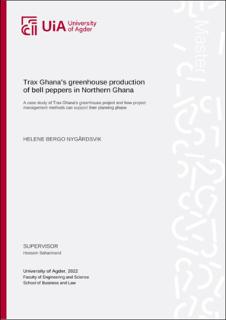Trax Ghana's greenhouse production of bell peppers in Northern Ghana
Abstract
This thesis seeks to uncover how the non-governmental organization, Trax Ghana, planned its first greenhouse project in the Upper East Region of Ghana. This was conducted by narrowing the analysis to how Trax Ghana planned its bell pepper production, which can provide implications for the overall planning phase. Interpretation of the findings related to their conducted planning phase lays the foundation for guiding how the planning phase can be supported. Establishing appropriate project management methods for the bell pepper production is particularly important as Trax Ghana supports its beneficiaries financially through the sales income from bell peppers. Supporting Trax Ghana’s achievement of its project objectives is the study’s main purpose. The thesis was conducted as a qualitative case study, with semi-structured interviews as the dominating applied technique for gathering data. Examination of project documents and unstructured observations supported the findings through interviews. Fieldwork in Ghana was also conducted to collect the necessary data to achieve the thesis’s objective. Trax Ghana’s planning phase had several deviations from the examined project management knowledge areas of project schedule management, project cost management, and project risk management. I find evidence that graphical techniques can support the project schedule management. As a solution, a Gantt chart was applied to share its project schedule. The most significant deviation is a lack of financial analysis for the bell pepper production, related to the project cost management. Financial analysis tools were developed in collaboration with Trax Ghana to address this. Lastly, Trax Ghana’s risk management can be supported by implementing a risk analysis. A template for risk assessment was therefore designed to support its risk management. In general, the findings uncover that Trax Ghana could benefit from expanding its current project management for its planning phase with additional project management methods.
